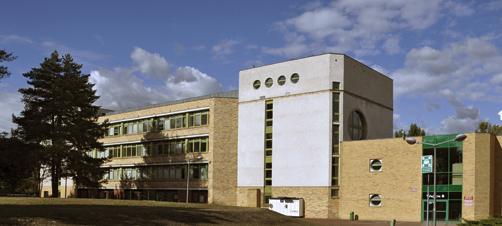Faculty of Physics and Astronomy
At present the Faculty of Physics includes the Institute of Acoustics, the Institute Astronomical Observatory, and 19 other Departments dedicated to particular subfields of physics.

The Morasko Campus where the Faculty has its prime location also hosts the Echoeless Chamber which apart from its unusual design not allowing any sound to penetrate its walls, also serves as a testing center for manufactured equipment and appliances to measure noise emission levels as described in the EU standards.
Predominant research areas of the Faculty include theoretical and experimental research in the fields of solid-state physics and also atomic, molecular and quantum optics and physics.
The NMR, EPR and NQR spectroscopy laboratories and the ultrafast optical spectroscopy laboratory constitute the great potential of the Faculty.
It is also interesting to know that...
...already 11 Asteroids
were discovered by AMU scientists
and named after them!
Learn more here
For many years now, the Faculty of Physics has been offering a wide range of educational programmes. Our fields of study include Physics, Astronomy, Biophysics (Optometry and Molecular Biophysics specializations), Acoustics (Hearing Prosthesis specialization), Medical Physics, Sound Engineering, Computer Technologies, Applications of the Internet of Things.
At the Faculty level a lot of theoretical, experimental and observational studies are conducted, among others, in the fields of Spintronics, Mesoscopic and Nanomaterial Physics, Soft Matter Physics, Computer Science and Quantum Optics, Condensed Matter Physics, Femtosecond Spectroscopy, Studies of Small Solar System Bodies, and Psychoacoustics.
Recently, the Faculty has successfully advanced new areas of research, in particular in the fields of the mesoscopic structures, quantum information science and biophysics.
The application of multi-planar imaging - the patented method by prof. Krzysztof Dobek from the Faculty of Physics
At the Faculty level a lot of theoretical, experimental and observational studies are conducted.
Among others, in the fields of Spintronics, Mesoscopic and Nanomaterial Physics, Soft Matter Physics, Computer Science and Quantum Optics, Condensed Matter Physics, Femtosecond Spectroscopy, Studies of Small Solar System Bodies, and Psychoacoustics. Recently, the Faculty has successfully advanced new areas of research, in particular in the fields of the mesoscopic structures, quantum information science and biophysics.
The Faculty cooperates with numerous academic institutions around the world. Scientists undergo postdoctoral trainings in various European countries and also in the USA and Japan.
People interested in Astronomy use the facilities of the Astronomical Observatory, located on Słoneczna St., in south-western part of Poznan.
Research conducted there includes celestial mechanics (the origin and orbital evolution of comets, dynamics of the artificial satellites and space debris), as well as photometry, spectroscopy and asteroid shapes modelling, and stellar astrophysics (photometry and spectroscopy of pulsating and multiple stars).
Benefits of completing our PAMEP studies
- PAMEP objective
The subject matter of the program is closely tied to physics of new materials which currently have been applied or have its potential application in energy generation, conversion, storage and saving. The PAMEP program will be conducted solely in the English language with emphasis on preparing its students for their future scientific or science-related careers. The goal of this program is to equip a student with technical expertise necessary for an academic career (postgraduate degree studies) or a career in private sector corporations which strictly rely on detailed knowledge of scientific research (for instance, companies involved in research, producing or servicing advanced measuring tools and companies interacting with both science and the industry).
- Why Poland?
Poland is a fascinating country that serves as the geographical and cultural crossroads of Eastern and Western Europe. The country enjoys a crucial position as the largest of the former Eastern European states and one of the most populous members of the EU. The Polish university education system has a history of 650 years of educating high profile professionals. Although Poland is undergoing a process of rapid economic development, the cost of living here is still significantly lower than in most EU countries.
- Why Poznań?
Poznań, a big, academic city with vibrant artistic life, a number of cultural events, clubs, restaurants, pubs, art galleries, exhibits, and monuments, offers the greatest cultural and intellectual experiences. The city is located halfway between Berlin and Warsaw; most European capitals are accessible within 2 hours by plane. It is a student-friendly city: every fourth inhabitant of Poznań is a student, and 46,000 of them study at Adam Mickiewicz University (AMU). AMU has been ranked among the Top-3 Universities in Poland for the last 5 years.
- Why PAMEP?
Our new specialization at Faculty of Physics, AMU – Physics of Advanced Materials for Energy Processing – proposes a new approach to graduate programs rooted in the rapidly developing fields of energy materials science which is essential to modern society.
- PAMEP – innovative way get M. Sc. degree in physics-related fields
- Individual approach: a limited number of students, the possibility to select the majority of classes, a close contact with the supervisors.
- Research: with the beginning of the second semester, students will join active research groups and start working on genuine scientific projects.
- Publication: the master’s dissertations can be based on the publication co-authored by the students.
- External practises: the last semester is devoted to an internship in another academic institution or in a private sector.



